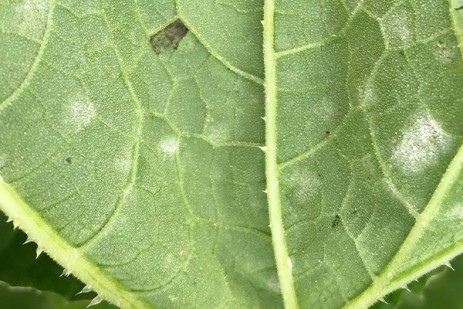Jul 1, 2021Pennsylvania vegetable disease update includes downy mildew sighting
Downy mildew was confirmed June 29 on cucumber in a commercial field in Lancaster County, Pennsylvania.
The field was likely infected around the same time as the reports last week in New Jersey and Maryland and these reports are about three weeks earlier than in the past six years. The field is actively being sprayed with fungicides that specifically target downy mildew.
Chart: Cucurbit downy mildew monitoring map as of 8:00 am 30 June 2021 (The Cucurbit Downy Mildew Forecast).
Last week there was also a confirmed report from Ontario, Canada along the Great Lakes. This means that there are sources of the pathogen that can infect cucumber and cantaloupe coming from the northwest and southeast depending on the forecasted weather conditions. It is highly recommended that all cucumber and cantaloupe crops be protected with fungicides even those being grown in high tunnels. The high relative humidity in a high tunnel can be enough for downy mildew to develop. In order to be used in a high tunnel, the product must be labeled for greenhouse use. See Table 4.4 in the 2020-21 Mid-Atlantic Vegetable Production Recommendations for a listing of products labeled for greenhouse production.
The closest report on a cucurbit crop other than cucumber and cantaloupe is in southern South Carolina on watermelon. The next closest is in southern Mississippi on butternut squash. The strain of the pathogen that infects pumpkin, squash, and watermelon is different from the one that infects cucumber and cantaloupe. This means that the downy mildew on your cucumbers will not infect your pumpkin or butternut squash.
It is important to be able to distinguish between downy mildew (oomycete pathogen – yellow/tan lesions on upper leaf surface and darker purplish sporulation on lower leaf surface), powdery mildew (fungal pathogen – white colonies on upper and lower leaf surface), and angular leaf spot (bacterial pathogen—no spores on the underside of the leaf). Although some protectant fungicides may help protect to varying degrees against these diseases, the recommended targeted products differ—especially for powdery and downy mildews.
Figure 1: Pictured on the left are powdery mildew (white colonies) and one downy mildew lesion (darker, purple sporulation) on the underside of a pumpkin leaf. Pictured on the right is angular leaf spot on the underside of a cucumber leaf. No sporulation will develop on the lower leaf surface. Photos: Beth K. Gugino/Penn State
If you suspect downy mildew on your farm, please let me know either by email at [email protected] or by phone at 814-865-7328 or contact your local Extension Office. Knowing where the disease is an important component for area-wide management. See the Cucurbit Downy Mildew Forecast for the latest reports and disease risk forecasts.
There are currently no reports of late blight on tomato or potato in the region. If you suspect late blight on your farm, please let me know either by email at [email protected] or by phone at 814-865-7328 or contact your local Extension Office.
Over the past few weeks, there have been a couple of reports of virus issues in garlic. It is common for garlic to test positive for potyviruses some of which include onion yellow dwarf virus, leek yellow stripe virus, as well as the garlic common latent virus – a member of the Carlavirus genus. Together these are often referred to as a garlic mosaic virus complex.
The symptoms often include a yellowing or yellow streaking of the leaves and stunting of the plants which could also be indicative of a nutrient deficiency. Symptoms tend to be more severe when plants are infected with multiple viruses. The viruses are primarily transmitted through vegetative propagation, but they can also be transmitted non-persistently by aphids passing through garlic and other Allium crops. Most plant disease diagnostic clinics can conduct a general test for the Potyvirus group and foliar tissue testing could also be used to identify potential nutrient deficiencies.

















